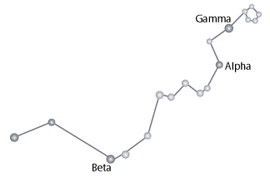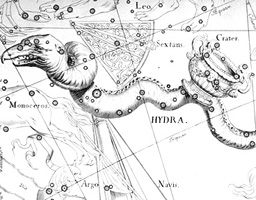Location: Northern Hemisphere & Southern Hemisphere
Coordinates:
Right Ascension: 10h
Declination: -20º
Source: Greek Mythology
The story behind the name: The constellation Hydra is most closely associated with the legend of the second labor of Heracles, which may echo a Babylonian legend in which the hero Gilgamesh killed a seven-headed monster. The Hydra was a fresh-water serpent born to Echidne and Typhon. Echidne was half woman, half serpent, herself a daughter of Ceto, a sea monster associated with the Babylonian Tiamat and the Hebrew Rahab. Typhon was associated with destructive winds, smoke and ash from volcanic eruptions, and the desert Sirocco. Typhon was also linked with the Egyptian god Set. Their child was destined to be a monster.
The Hydra had a dog-like body and a minimum of eight or nine snake heads (some stories say there were hundreds or thousands). One of the heads was immortal. Hydra's breath could destroy life, and her blood was highly poisonous. The Hydra had her den beneath a plane tree at the source of the river Amymone, and lived in the Lernaen swamp. At Lerna, between the Amymone and the Pontinus rivers, was a sacred area with shrines to Athene, Demeter, Dionysus, and Aphrodite, and a marker at the spot where Hades and Persephone were supposed to have entered the Underworld. Hydra terrorized the district, disrupting the sacred rites.
Hera, who disliked Heracles and is credited with inducing themadness that caused him to kill his children and thus undergo the twelve labors, is also said to have raised the Hydra specifically as a menace to Heracles. Athena helped Heracles in this labor by identifying Hydra's den and advising him on tactics. Heracles forced the Hydra out of her den with burning arrows and then had to hold his breath while wrestling with her. He was almost overwhelmed because each time he bashed or cut off a head, one or more appeared in its place. A crab tried to aid the Hydra by biting Heracles on the foot.
Iolus, Heracles' chariot driver, finally started a fire in the grove so that he could have a constant supply of burning branches with which to scorch the roots of the severed heads and prevent new ones from growing back. Heracles was able to sever the immortal head and bury it. He dipped his arrows in the Hydra's blood and from then on, any wound they caused was fatal. Heracles did not get credit for accomplishing this labor because Iolus had provided crucial help.
Introduction to Constellations | Constellation Sources | Constellations Index
Objects observed by Chandra in Hydra:



